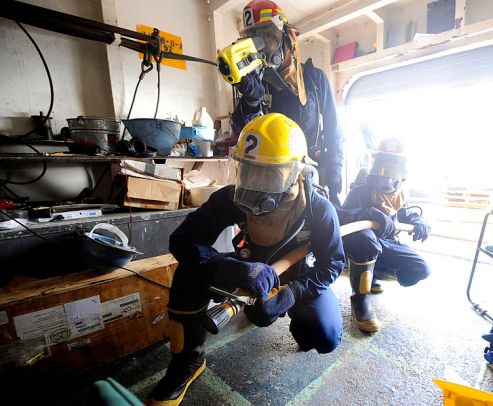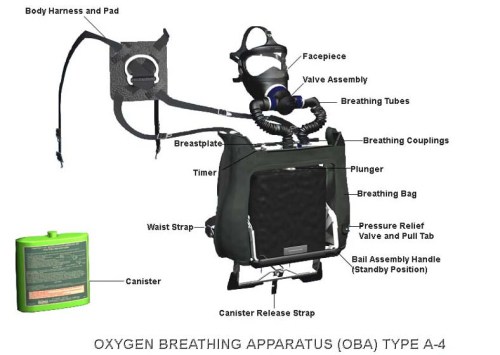FIRE !! FIRE !!
These are U.S. Navy firefighters. I spent 8 years in the Navy and among other things I was a firefighter. I was a shipfitter/hull maintenance technician. I was well trained in firefighting and damage control and taught many others aboard ship. Fortunately during those 8 years the only fires I had to deal with were relatively small. Another one of my jobs in the Navy was welding. It is very common for welding operations to create fires so we had to always be alert and act quickly to extinguish the fires before they grew out of control. I have been a weldor thruout my civilian life as well so I still had to deal with fires. Fires are a very serious matter and even more so aboard ship. Although it is true there is no shortage of water available (saltwater) there is the matter of placing water inside of the ship as it can only hold so much before it affects the ship’s buoyancy and stability. And besides, there is a whole lot of stuff that any water and especially salt water can destroy. Another factor is that unlike dealing with a fire on land there is no place to escape to so the fire must be contained and conquered quickly as the personnel aboard are in grave danger.
When I look at these pictures it is almost too much for me to fathom as it wasn’t like this when I was in the Navy. We had no special firefighting clothing or high tech equipment. All we had is our work uniform and an OBA (oxygen breathing apparatus). Today navy firefighters have pretty much the same equipment and protective clothing as civilian firefighters.
Here is the old technology. Now they use compressed gas cylinders as seen in the images above.
I was usually either the number one OBAman or the Scene Leader. The number one OBAman is the one who is actually most upfront dealing with the emergency at hand. The number two OBAman is directly behind him and his job is to provide protection for the number one OBAman. The number one OBAman is more less in charge of dealing with the scene of the fire since he is the one there. The Scene Leader is in charge overall of the entirety of the scene, but he remains back where it is safe until such time as the actual scene of the fire has been made safe for others to go to without special safety equipment such as wearing an OBA. He can send in orders and suggestions to the number one OBAman so that is why I said the the number one OBAman is more less in charge at the actual scene. Obviously since he is the one right there dealing with what is going on he has to call the shots according to his training, knowledge and best guess. And obviously sometimes someone who is further back has a different perspective than someone who is right on top of things. There is also a number three OBAman whose job it is to help handle hoses and assist on the scene in anyway needed including running messages back and forth to and from the scene leader. The scene leader, although in charge of the scene, is functioning under the authority of the Damage Control Assistant (DCA) who is an officer. The DCA is under the authority of the Damage Control Officer and he is under the authority of the captain. So as you can see there is a chain of command.
Anyway, my Navy training helped me considerably in civilian life as I have had to put it to use more in civilian life than I did in the navy. Fire which is under control can be a real friend but out of control it can be a horrible terrifying enemy.
A basic fire consists of three elements … fuel, oxygen and heat. All three must be present in order for a fire to occur.
Firefighting consists of removing one or more of these three elements. If you remove the fuel source the fire will go out. Physically removing flammable materials, shutting off fuel (liquid fuel flowing thru piping or leaking tanks, etc.) are means of removing fuel sources. If you remove the oxygen the fire will go out. Displacing the oxygen with CO2, Dry Chemical, Steam, etc. are common means of dealing with the element of oxygen. If you remove the heat the fire will go out. Water removes the heat. Of course, once the fire is out it is important that the source of fuel be totally removed or extinguished as otherwise the fire can restart. Any remaining “hot spots” need to be eliminated. This is done by raking apart embers and using water on them to further cool them so they won’t reignite. Obviously there isn’t much that can be done about the presence of oxygen since the atmosphere is about 21 percent is oxygen.
Aboard ship there are special fuels and concerns which go beyond a simple basic fire like I have been talking about up until now. Magnesium is one of those special fuels that pose a very serious threat. When magnesium burns it produces it own oxygen and so it burns intensely. It can literally melt steel and burn it’s way thru … going thru bulkheads (walls) and decks (floors) … sometimes one after another. Theoretically an intense magnesium fire could burn thru the hull of a ship and possibly sink it. Magnesium which is on fire can not just be sprayed with water like a common fire. To do so would cause it to explode violently and cause much further damage and threat including great harm to personnel. Burning magnesium requires huge amounts of water to put it out. The best thing is to toss it overboard into the ocean … submerging it is a large quantity of water. I don’t know if it has changed or not, but when I served in the Navy helicopters had a lot of magnesium in their construction. Our training in firefighting a crashed helicopter was to lay down fire fighting foam up to the burning helicopter to try to control burning fuel on deck and then quickly approach it wearing a special aluminumized proximity suit to rescue personnel from the helicopter. The priority of rescue was always: pilot first, co-pilot second and others afterwards. Then the helicopter was to be shoved over the side of the ship into the ocean.
Again, fortunately we never had to deal with this scenario. It is a good thing to as many times the helicopter came and left before we could even get ready as a firefighting team. We were not given sufficient notice to “set the helo detail”.
Yes, fire is a most serious thing. It can be a real killer. At the very least it can do tremendous damage and we can suffer great loss. We should always be on guard and careful as a fire is all too easy to start and get out of control quickly. Many years ago when we lived down in Georgia we were awakened early on a Sunday morning by someone banging loudly on our front door. I got up and went to the door but no one was there. I looked over to the other side of our home (a mobile home) where a sliding glass patio door was at and had vertical blinds installed. I noticed it was sort of a bright orange in color … unusual. It caught my attention so I went over to it and peeked out between the vertical blinds. I was not expecting what I saw. Our next door neighbor’s mobile home was on fire and as mobile homes go it was spreading quickly. I yelled at my wife to alert her so she could get dressed and be prepared to do whatever we needed to do ourselves as certainly it was possible for the fire to spread to our home. The firefighting training kicked in and after quickly dressing I ran outside and grabbed our garden hose. It isn’t sufficient to fight such a fire but it would help until the fire dept. arrived. I turned on the valve and nothing … no water. I couldn’t believe it … as in this can’t be happening. So I couldn’t do anything as far as fighting the fire. The police showed up first and made us move further back away. The fire dept. showed up and fought the fire and got it under control and eventually put it out. The mobile home was a total loss. The saddest part of it all is that our neighbor died of smoke inhalation. She was an elderly widow. We had just had her over to our home a few days before this for Thanksgiving. There is good news in the midst of this sad story. She got saved just two or three weeks before her death. She gave her heart and life to Jesus. She was ready for death even though I am sure she was not expecting it that morning. We never know what a day will bring forth. It could be our last day … any one of us could suddenly die. Are you ready for death?
I have been talking about fire. There is another fire God’s Word speaks about. This one can’t be put out and it will burn forever …
HELLFIRE !!!!
The billions of souls who will spend eternity there will be in great torment and anguish. The fire of hell will not burn out like those here on earth we deal with. And those who go there will not be destroyed (burnt up). The torment will be everlasting. No one has to go there however. God has provided the means to escape such a fate. All we have to do is come to Him on His terms.
Truly it is better to turn than burn!
Posted on May 20, 2014, in truth to ponder and tagged 3 elements of a fire, aluminized proximity suit, damage controlman, eternal damnation, eternal life, fire triangle, helicopter crash, hell, hellfire, hull maintenance technician, navy firefighting, OBA, OBAman, OBAmen, oxygen breathing apparatus, repentance, salvation, shipboard fire, shipfitter, turn or burn, U.S. Navy firefighters. Bookmark the permalink. Leave a comment.







Leave a comment
Comments 0